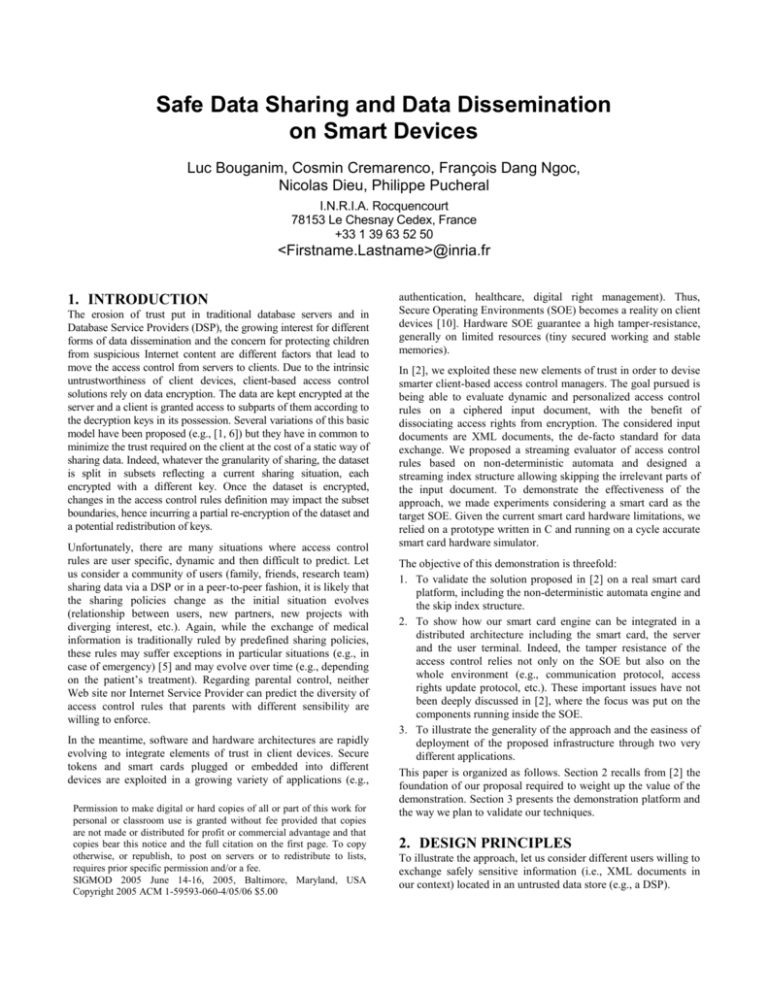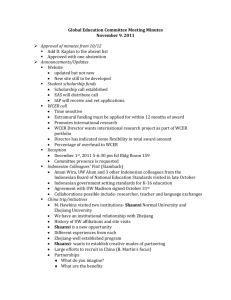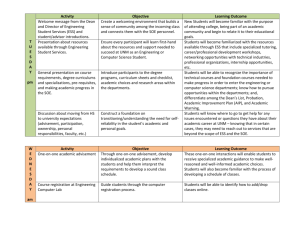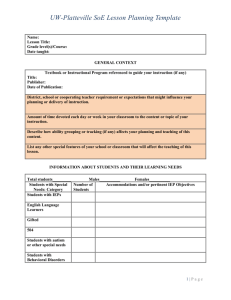SIGDEMO_V19
advertisement

Safe Data Sharing and Data Dissemination
on Smart Devices
Luc Bouganim, Cosmin Cremarenco, François Dang Ngoc,
Nicolas Dieu, Philippe Pucheral
I.N.R.I.A. Rocquencourt
78153 Le Chesnay Cedex, France
+33 1 39 63 52 50
<Firstname.Lastname>@inria.fr
1. INTRODUCTION
The erosion of trust put in traditional database servers and in
Database Service Providers (DSP), the growing interest for different
forms of data dissemination and the concern for protecting children
from suspicious Internet content are different factors that lead to
move the access control from servers to clients. Due to the intrinsic
untrustworthiness of client devices, client-based access control
solutions rely on data encryption. The data are kept encrypted at the
server and a client is granted access to subparts of them according to
the decryption keys in its possession. Several variations of this basic
model have been proposed (e.g., [1, 6]) but they have in common to
minimize the trust required on the client at the cost of a static way of
sharing data. Indeed, whatever the granularity of sharing, the dataset
is split in subsets reflecting a current sharing situation, each
encrypted with a different key. Once the dataset is encrypted,
changes in the access control rules definition may impact the subset
boundaries, hence incurring a partial re-encryption of the dataset and
a potential redistribution of keys.
Unfortunately, there are many situations where access control
rules are user specific, dynamic and then difficult to predict. Let
us consider a community of users (family, friends, research team)
sharing data via a DSP or in a peer-to-peer fashion, it is likely that
the sharing policies change as the initial situation evolves
(relationship between users, new partners, new projects with
diverging interest, etc.). Again, while the exchange of medical
information is traditionally ruled by predefined sharing policies,
these rules may suffer exceptions in particular situations (e.g., in
case of emergency) [5] and may evolve over time (e.g., depending
on the patient’s treatment). Regarding parental control, neither
Web site nor Internet Service Provider can predict the diversity of
access control rules that parents with different sensibility are
willing to enforce.
In the meantime, software and hardware architectures are rapidly
evolving to integrate elements of trust in client devices. Secure
tokens and smart cards plugged or embedded into different
devices are exploited in a growing variety of applications (e.g.,
Permission to make digital or hard copies of all or part of this work for
personal or classroom use is granted without fee provided that copies
are not made or distributed for profit or commercial advantage and that
copies bear this notice and the full citation on the first page. To copy
otherwise, or republish, to post on servers or to redistribute to lists,
requires prior specific permission and/or a fee.
SIGMOD 2005 June 14-16, 2005, Baltimore, Maryland, USA
Copyright 2005 ACM 1-59593-060-4/05/06 $5.00
SIGMOD/PODS’05, June 13, 2005, Baltimore, Maryland, USA.
authentication, healthcare, digital right management). Thus,
Secure Operating Environments (SOE) becomes a reality on client
devices [10]. Hardware SOE guarantee a high tamper-resistance,
generally on limited resources (tiny secured working and stable
memories).
In [2], we exploited these new elements of trust in order to devise
smarter client-based access control managers. The goal pursued is
being able to evaluate dynamic and personalized access control
rules on a ciphered input document, with the benefit of
dissociating access rights from encryption. The considered input
documents are XML documents, the de-facto standard for data
exchange. We proposed a streaming evaluator of access control
rules based on non-deterministic automata and designed a
streaming index structure allowing skipping the irrelevant parts of
the input document. To demonstrate the effectiveness of the
approach, we made experiments considering a smart card as the
target SOE. Given the current smart card hardware limitations, we
relied on a prototype written in C and running on a cycle accurate
smart card hardware simulator.
The objective of this demonstration is threefold:
1. To validate the solution proposed in [2] on a real smart card
platform, including the non-deterministic automata engine and
the skip index structure.
2. To show how our smart card engine can be integrated in a
distributed architecture including the smart card, the server
and the user terminal. Indeed, the tamper resistance of the
access control relies not only on the SOE but also on the
whole environment (e.g., communication protocol, access
rights update protocol, etc.). These important issues have not
been deeply discussed in [2], where the focus was put on the
components running inside the SOE.
3. To illustrate the generality of the approach and the easiness of
deployment of the proposed infrastructure through two very
different applications.
This paper is organized as follows. Section 2 recalls from [2] the
foundation of our proposal required to weight up the value of the
demonstration. Section 3 presents the demonstration platform and
the way we plan to validate our techniques.
2. DESIGN PRINCIPLES
To illustrate the approach, let us consider different users willing to
exchange safely sensitive information (i.e., XML documents in
our context) located in an untrusted data store (e.g., a DSP).
Secured channel
Access control rules
Encryption keys
Client device
[Query]
SOE
Decryption
Integrity control
Access control
Authorized
doc view
or
Authorized
query result
Encrypted XML doc.
Figure 1. Target architecture
Basically, when a user issues a query to the data store, the SOE
fetches the appropriate encrypted XML document from the server,
decrypts it, checks that it has not been tampered, enforces the
access control on it and delivers the authorized subpart matching
the query. While this example illustrates a pull-based scenario,
our approach can support push-based scenarios (e.g., selective
data dissemination) in a very similar way. In the following, we
first depict the abstract architecture; then we present the access
control model and finally describe the proposed streaming access
control mechanism.
2.1 Target architecture
Figure 1 pictures an abstract representation of the target
architecture for the applications mentioned in the introduction.
The access control being evaluated on the client, the client device
has to be made tamper resistant thanks to a Secure Operating
Environment (SOE) (e.g., a smart card). We make the following
traditional assumptions on the SOE: 1) the code executed by the
SOE cannot be corrupted, 2) the SOE has at least a small quantity
of secure stable storage (to store secrets like encryption keys), 3)
the SOE has at least a small quantity of secure working memory
(to protect sensitive data structures at processing time).
In our context, the SOE is in charge of decrypting the input
document, checking its integrity and evaluating the access control
policy corresponding to a given (document, subject) pair. Under
the assumption that the SOE is secure, the only way to mislead the
access control rule evaluator is to tamper the input document, for
example by substituting or modifying encrypted blocks, thus
motivating the encryption and integrity checking.
Access control policies as well as the key(s) required to decrypt
the document can be either permanently hosted by the SOE,
refreshed or downloaded via a secure channel from different
sources (trusted server, license provider, server managing parent’s
consent, etc).
2.2 Access Control Model
Several authorization models have been recently proposed for
regulating access to XML documents. We introduce below a
simplified access control model for XML, inspired by Bertino’s
model [1] and Samarati’s model [3] that roughly share the same
foundation. Subtleties of these models are ignored for the sake of
simplicity. In this simplified model, access control rules, or access
rules for short, take the form of a 3-uple <sign, subject, object>.
* R: , //b[c]/d
1
b
b
2
4
d
c
3
5
Figure 2. Access control rule automaton
Sign denotes either a permission (positive rule) or a prohibition
(negative rule) for the read operation. Subject is self-explanatory.
Object corresponds to elements or subtrees in the XML document,
identified by an XPath expression. We consider here a rather robust
subset of XPath denoted by XP{[],*,//} [7]. This subset, widely used in
practice, consists of node tests, the child axis (/), the descendant axis
(//), wildcards (*) and predicates or branches […]. The cascading
propagation of rules is implicit in the model, meaning that a rule
propagates from an object to all its descendants in the XML
hierarchy. Due to this propagation mechanism and to the
multiplicity of rules for a same user, a conflict resolution principle
is required. Conflicts are resolved using two policies: 1) DenialTakes-Precedence, which states that if two rules of opposite signs
apply on the same object, then the negative one prevails and 2)
Most-Specific-Object-Takes-Precedence, which states that a rule
which applies directly to an object takes precedence over a
propagated rule.
2.3 Efficient streaming access control
The streaming requirement is twofold. First, the evaluator must
adapt to the memory constraint of the SOE, thereby precluding
materialization (e.g., building a DOM representation of the
document). Second, some target applications mentioned in the
introduction are likely to consume streaming documents (e.g.,
selective data dissemination). Efficiency is, as usual, an important
concern, and leads to rely on indexing to quickly converge
towards the authorized parts of the input document, while
skipping the others. Indexing is of utmost importance considering
the two limiting factors of the target architecture: the cost of
decryption in the SOE and the cost of communication between the
SOE, the client and the server.
Access rules evaluation
At first glance, streaming access control resembles the wellknown problem of XPath processing on streaming documents [8],
which has been widely studied notably in the context of XML
filtering [4]. While access rules are expressed in XPath, the nature
of our problem differs significantly from the preceding ones
because rules are not independent, bringing two new issues: 1) at
parsing time the evaluator must be capable of determining the set
of rules targeting a given node and deciding which one apply
according to the conflict resolution policies and 2) some rules
may be inhibited by others according to the conflict resolution
policies, thereby optimizations such as suspending evaluations of
rules can be devised.
As streaming documents are considered, we make the assumption
that the evaluator is fed by an event-based parser (e.g., SAX)
raising open, value and close events respectively for each
opening, text and closing tag in the input document. Each access
rule is represented by a non-deterministic automaton, as pictured
in Figure 2. This automaton is made up of a navigational path (in
white in the figure) representing the XPath without its predicate
and predicate paths (in gray in the figure) appended to it.
Basically, when an open or a value event is received, all the
automata are checked and go to their next state. Upon receiving a
close event, all the automata backtrack. To manage these automata
efficiently, we use a stack that keeps track of active states,
materializing all the possible paths that can be followed on the
non-deterministic automata. In order for a rule to apply, all its
final states must be reached. This is controlled using a predicate
set which records all the final states of predicates that have been
reached. In some cases, the final state of a navigational path may
be reached while those of its predicate paths are not. In these
cases, the rule is said to be pending, meaning that the nodes upon
which it applies are to be delivered only if, later on in the parsing,
all the predicate paths are found to reach their final states. Finally,
propagation of rules as well as conflicts are managed with a sign
stack which keeps on the top, the current sign that is propagated if
no other rule applies. More details can be found in [2].
Skip index
To reduce the flow of data received by the SOE and thus the
decryption time, we devise a new indexation structure that enables
to skip irrelevant (i.e., forbidden) parts of the documents. The first
distinguishing feature of the required index is the necessity to
keep it encrypted outside of the SOE to guarantee the absence of
information disclosure. The second distinguishing feature (related
to the first one and to the SOE storage capacity) is that the SOE
must manage the index in a streaming fashion, similarly to the
document itself. These two features lead to design a very compact
index (its decryption and transmission overhead must not exceed
its own benefit), embedded in the document in a way compatible
with streaming. For these reasons, we concentrate on indexing the
structure of the document, pushing aside the indexation of its
content. The objective of the index is to detect rules and queries
that cannot apply inside a given subtree, with the expected benefit
to skip this subtree if it turns out to be forbidden or irrelevant wrt
the query. Keeping the compactness requirement in mind, the
minimal information required to achieve this goal is the set of
element tags that appear in each subtree (to check whether an
access rule automaton is likely to reach its final state) as well as
the subtree size (to make the skip actually possible). Although this
metadata does not capture the tag nesting, it reveals oneself as a
very effective way to filter out irrelevant access control rules. For
ensuring compactness, we compress the document structure using
a dictionary of tags [9] and encode the set of tags thanks to a bit
array referring to the tag dictionary. To further reduce the
indexing overhead, we apply recursive compression on both the
set of tags bit array and the subtree size. More details can be
found in [2].
3. THE DEMONSTRATOR
The demonstration platform includes the whole prototype
architecture as well as two applications. The architecture, depicted
in Figure 3, is composed of:
a terminal connected to the smart card. It contains a proxy
allowing the applications to communicate easily with the
different elements of the architecture through an XML API
independent of the underlying protocols (JDBC, APDU1).
a DSP which hosts encrypted XML documents shared by users
as well as encrypted access rules. Both are encrypted using
secret keys exchanged between users thanks to a public key
infrastructure (PKI)2.
a smart card in charge of enforcing access control. For the
demonstration, we use e-gate smart cards developed by Axalto,
1
2
Figure 3. Architecture
a subsidiary of Schlumberger. These smart cards provide a
powerful CPU and strong security features but still have a
limited memory (only 1 KB of RAM available for on-board
applications) and a low bandwidth (2KB/s).
The advantage provided by this architecture is twofold. First, the
complexity of the access control, query and security management
is confined in the smart card and its proxy, so that the application
developer can concentrate on the application logic. Second, the
proposed architecture complies with the standards. Documents are
described in XML and both access control rules and queries are
expressed in XPath, two very popular W3C standards.
To assess the generality of the approach, the features of our
prototype will be demonstrated through two applications. The first
application deals with collaborative works among a community of
users while the second one deals with the selective dissemination
of multimedia streams through unsecured channels. They are
representative of two rather different profiles regarding the way
the information is accessed (pull vs. push), the type of this
information (textual vs. video) and the response time requirements
(user patience / real time).
4. REFERENCES
[1] Bertino, E., Castano, S., Ferrari, E. Securing XML documents
with Author-X, IEEE Internet Computing, 2001.
[2] Bouganim, L., Dang Ngoc, F., Pucheral, P. Client-Based
Access Control Management for XML Documents, VLDB,
2004.
[3] Damiani, E., De Capitani di Vimercati, S., Paraboschi, S.,
Samarati, P. A Fine-Grained Access Control System for XML
Documents, ACM TISSEC, vol. 5, n. 2, 2002.
[4] Diao, Y., Franklin, M. High-Performance XML Filtering: An
Overview of YFilter, ICDE, 2003.
[5] El Kalam, A., Benferhat, S., Miege, A., Baida, R., Cuppens,
F., Saurel, C., Balbiani, P., Deswarte, Y., Trouessin, G.
Organization based access control, IEEE POLICY, 2003.
[6] Hacigumus, H., Iyer, B., Li, C., Mehrotra, S. Executing SQL
over encrypted data in the database-service-provider model,
ACM SIGMOD, 2002.
[7] Miklau, G., Suciu, D. Containment and equivalence for an
XPath fragment, ACM PODS, 2002.
[8] Peng, F., Chawathe, S. XPath Queries on Streaming Data,
ACM SIGMOD, 2003.
Application Protocol Data Unit: Communication protocol between the
terminal and the smart card
In the demonstration, we will not use a PKI infrastructure but rather
simulate it to keep the demonstration independent of a network
connection. Moreover, PKI is a well-known technique that need not be
demonstrated.
[9] Tolani, P., Haritsa, J. XGRIND: A Query-Friendly XML
Compressor, ICDE, 2002.
[10] Vingralek, R. GnatDb: A Small-Footprint, Secure Database
System, VLDB, 2002.







